Financial Ratio Analysis of Frank's Restaurant (2011-2015)
VerifiedAdded on 2021/01/02
|9
|1613
|35
Report
AI Summary
This report presents a comprehensive ratio analysis of Frank's Restaurant's financial performance from 2011 to 2015. The analysis includes calculations and interpretations of various financial ratios, such as current ratio, quick ratio, net working capital ratio, cash ratio, asset turnover ratio, profit margin ratio, return on total assets, and sales to inventory ratio. The report evaluates the restaurant's liquidity, operational efficiency, financial solvency, profitability, and asset management capabilities. It highlights trends and provides insights into the company's financial health, including its ability to manage assets, generate profits, and meet short-term obligations. The report references relevant academic sources to support the analysis and includes projected financial statements for the period, providing a detailed overview of the restaurant's financial position and performance over the five-year period.

Business
Paraphrase This Document
Need a fresh take? Get an instant paraphrase of this document with our AI Paraphraser
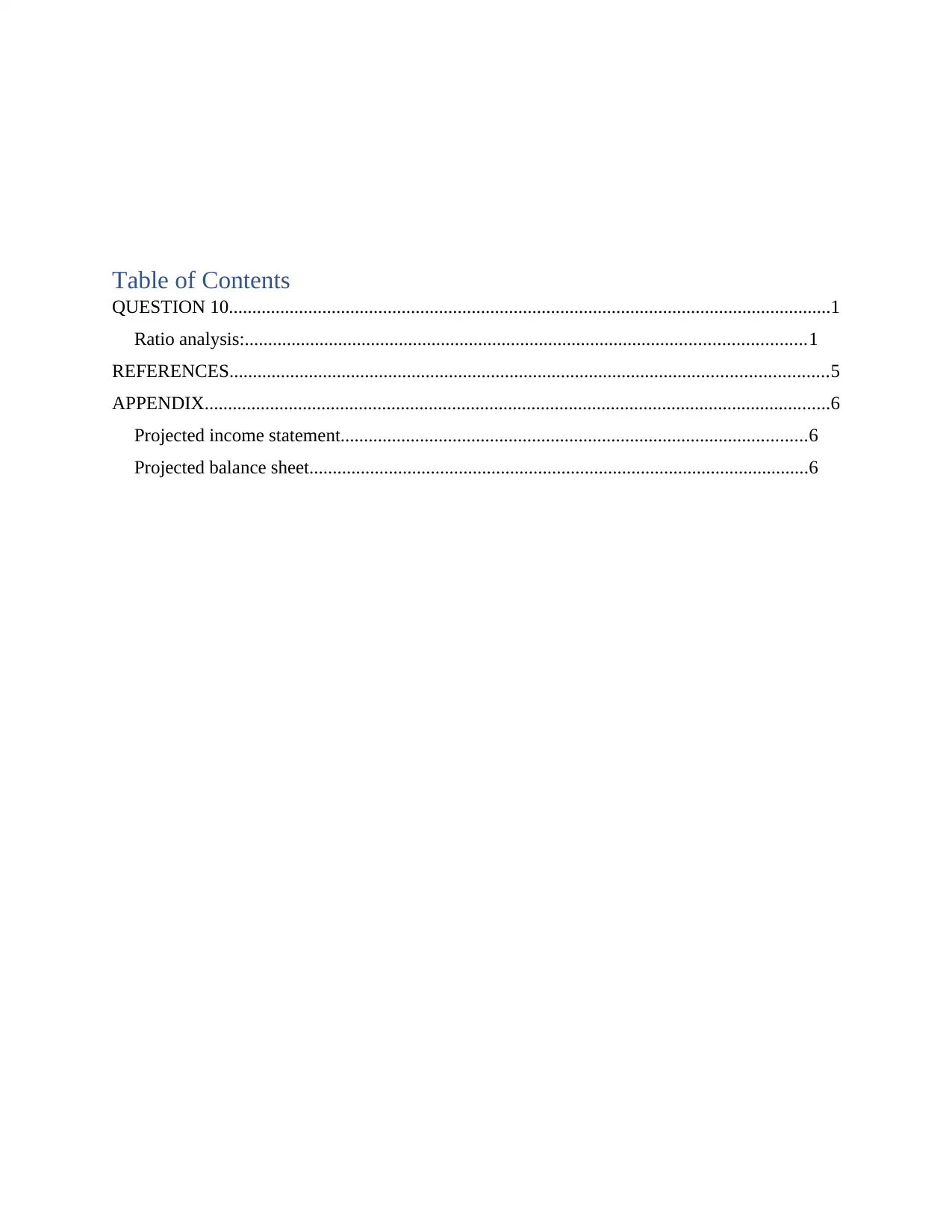
Table of Contents
QUESTION 10.................................................................................................................................1
Ratio analysis:........................................................................................................................1
REFERENCES................................................................................................................................5
APPENDIX......................................................................................................................................6
Projected income statement....................................................................................................6
Projected balance sheet...........................................................................................................6
QUESTION 10.................................................................................................................................1
Ratio analysis:........................................................................................................................1
REFERENCES................................................................................................................................5
APPENDIX......................................................................................................................................6
Projected income statement....................................................................................................6
Projected balance sheet...........................................................................................................6
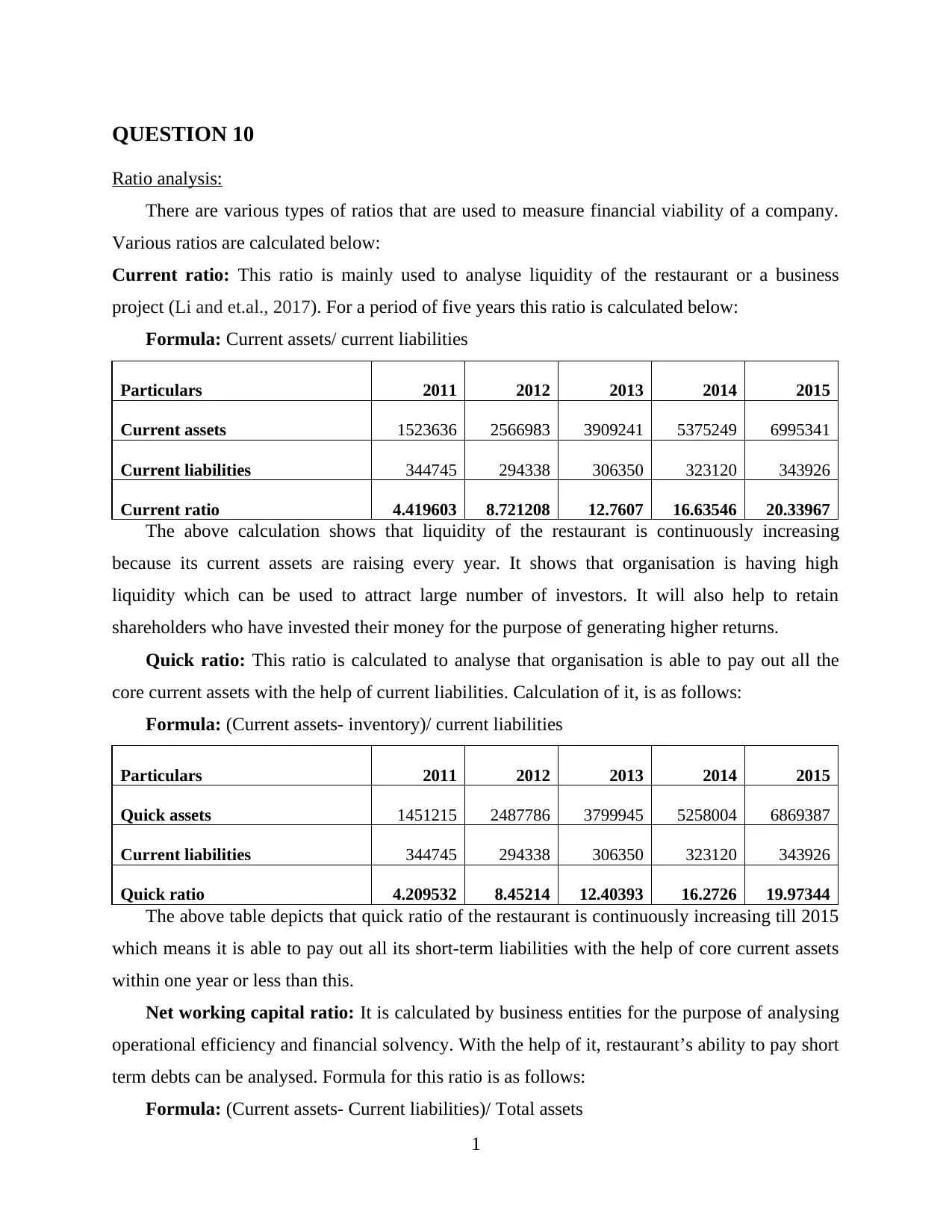
QUESTION 10
Ratio analysis:
There are various types of ratios that are used to measure financial viability of a company.
Various ratios are calculated below:
Current ratio: This ratio is mainly used to analyse liquidity of the restaurant or a business
project (Li and et.al., 2017). For a period of five years this ratio is calculated below:
Formula: Current assets/ current liabilities
Particulars 2011 2012 2013 2014 2015
Current assets 1523636 2566983 3909241 5375249 6995341
Current liabilities 344745 294338 306350 323120 343926
Current ratio 4.419603 8.721208 12.7607 16.63546 20.33967
The above calculation shows that liquidity of the restaurant is continuously increasing
because its current assets are raising every year. It shows that organisation is having high
liquidity which can be used to attract large number of investors. It will also help to retain
shareholders who have invested their money for the purpose of generating higher returns.
Quick ratio: This ratio is calculated to analyse that organisation is able to pay out all the
core current assets with the help of current liabilities. Calculation of it, is as follows:
Formula: (Current assets- inventory)/ current liabilities
Particulars 2011 2012 2013 2014 2015
Quick assets 1451215 2487786 3799945 5258004 6869387
Current liabilities 344745 294338 306350 323120 343926
Quick ratio 4.209532 8.45214 12.40393 16.2726 19.97344
The above table depicts that quick ratio of the restaurant is continuously increasing till 2015
which means it is able to pay out all its short-term liabilities with the help of core current assets
within one year or less than this.
Net working capital ratio: It is calculated by business entities for the purpose of analysing
operational efficiency and financial solvency. With the help of it, restaurant’s ability to pay short
term debts can be analysed. Formula for this ratio is as follows:
Formula: (Current assets- Current liabilities)/ Total assets
1
Ratio analysis:
There are various types of ratios that are used to measure financial viability of a company.
Various ratios are calculated below:
Current ratio: This ratio is mainly used to analyse liquidity of the restaurant or a business
project (Li and et.al., 2017). For a period of five years this ratio is calculated below:
Formula: Current assets/ current liabilities
Particulars 2011 2012 2013 2014 2015
Current assets 1523636 2566983 3909241 5375249 6995341
Current liabilities 344745 294338 306350 323120 343926
Current ratio 4.419603 8.721208 12.7607 16.63546 20.33967
The above calculation shows that liquidity of the restaurant is continuously increasing
because its current assets are raising every year. It shows that organisation is having high
liquidity which can be used to attract large number of investors. It will also help to retain
shareholders who have invested their money for the purpose of generating higher returns.
Quick ratio: This ratio is calculated to analyse that organisation is able to pay out all the
core current assets with the help of current liabilities. Calculation of it, is as follows:
Formula: (Current assets- inventory)/ current liabilities
Particulars 2011 2012 2013 2014 2015
Quick assets 1451215 2487786 3799945 5258004 6869387
Current liabilities 344745 294338 306350 323120 343926
Quick ratio 4.209532 8.45214 12.40393 16.2726 19.97344
The above table depicts that quick ratio of the restaurant is continuously increasing till 2015
which means it is able to pay out all its short-term liabilities with the help of core current assets
within one year or less than this.
Net working capital ratio: It is calculated by business entities for the purpose of analysing
operational efficiency and financial solvency. With the help of it, restaurant’s ability to pay short
term debts can be analysed. Formula for this ratio is as follows:
Formula: (Current assets- Current liabilities)/ Total assets
1
⊘ This is a preview!⊘
Do you want full access?
Subscribe today to unlock all pages.

Trusted by 1+ million students worldwide

Particulars 2011 2012 2013 2014 2015
Working capital 1178891 2272645 3602891 5052129 6651415
Total assets 1961546 3004893 4347151 5843159 7433251
Net working capital ratio 0.601001 0.756315 0.828794 0.864623 0.894819
From the above table it can be analysed that net working capital ratio of Frank’s
restaurant is increasing due to increment in current and total assets and current liabilities. It helps
stakeholders to determine that the organisation in which they have invested their money is able
to pay its short-term debts on time or not.
Cash ratio: This ratio is calculated by business entities in order to analyse raise cash money
in a short time period. It helps investors to analyse financial stability of the restaurant. Formula
of this ratio is as follows:
Formula: Cash/ Current liabilities
Particulars 2011 2012 2013 2014 2015
Cash 1172844 2209415 3521573 4979631 6591014
Current liabilities 344745 294338 306350 323120 343926
Cash ratio 3.402062 7.506387 11.49526 15.41109 19.16405
From the above calculations it can be analysed that Frank’s Restaurant is having high cash ratio
which is increasing every year from 2011 to 2015. It can help investors of the company to
analyse that organisation is having high liquidity or not. With the help of it ability of the
restaurant to generate funds (Zhu and et.al., 2015).
Asset turnover ratio: This ratio is calculated by organisations to analyse capability of
organisation to handle assets in appropriate manner. With the help of it, ability of restaurant to
generate sales with the help of its assets. Formula for this ratio is as follows:
Formula: Sales/ average total assets
Particulars 2011 2012 2013 2014 2015
Sales 4191683 4585163 4904564 5253740 5636277
Average total assets 1483085 2483220 3676022 5095155 6638205
Asset turnover ratio 2.826327 1.846459 1.334204 1.031125 0.849066
2
Working capital 1178891 2272645 3602891 5052129 6651415
Total assets 1961546 3004893 4347151 5843159 7433251
Net working capital ratio 0.601001 0.756315 0.828794 0.864623 0.894819
From the above table it can be analysed that net working capital ratio of Frank’s
restaurant is increasing due to increment in current and total assets and current liabilities. It helps
stakeholders to determine that the organisation in which they have invested their money is able
to pay its short-term debts on time or not.
Cash ratio: This ratio is calculated by business entities in order to analyse raise cash money
in a short time period. It helps investors to analyse financial stability of the restaurant. Formula
of this ratio is as follows:
Formula: Cash/ Current liabilities
Particulars 2011 2012 2013 2014 2015
Cash 1172844 2209415 3521573 4979631 6591014
Current liabilities 344745 294338 306350 323120 343926
Cash ratio 3.402062 7.506387 11.49526 15.41109 19.16405
From the above calculations it can be analysed that Frank’s Restaurant is having high cash ratio
which is increasing every year from 2011 to 2015. It can help investors of the company to
analyse that organisation is having high liquidity or not. With the help of it ability of the
restaurant to generate funds (Zhu and et.al., 2015).
Asset turnover ratio: This ratio is calculated by organisations to analyse capability of
organisation to handle assets in appropriate manner. With the help of it, ability of restaurant to
generate sales with the help of its assets. Formula for this ratio is as follows:
Formula: Sales/ average total assets
Particulars 2011 2012 2013 2014 2015
Sales 4191683 4585163 4904564 5253740 5636277
Average total assets 1483085 2483220 3676022 5095155 6638205
Asset turnover ratio 2.826327 1.846459 1.334204 1.031125 0.849066
2
Paraphrase This Document
Need a fresh take? Get an instant paraphrase of this document with our AI Paraphraser
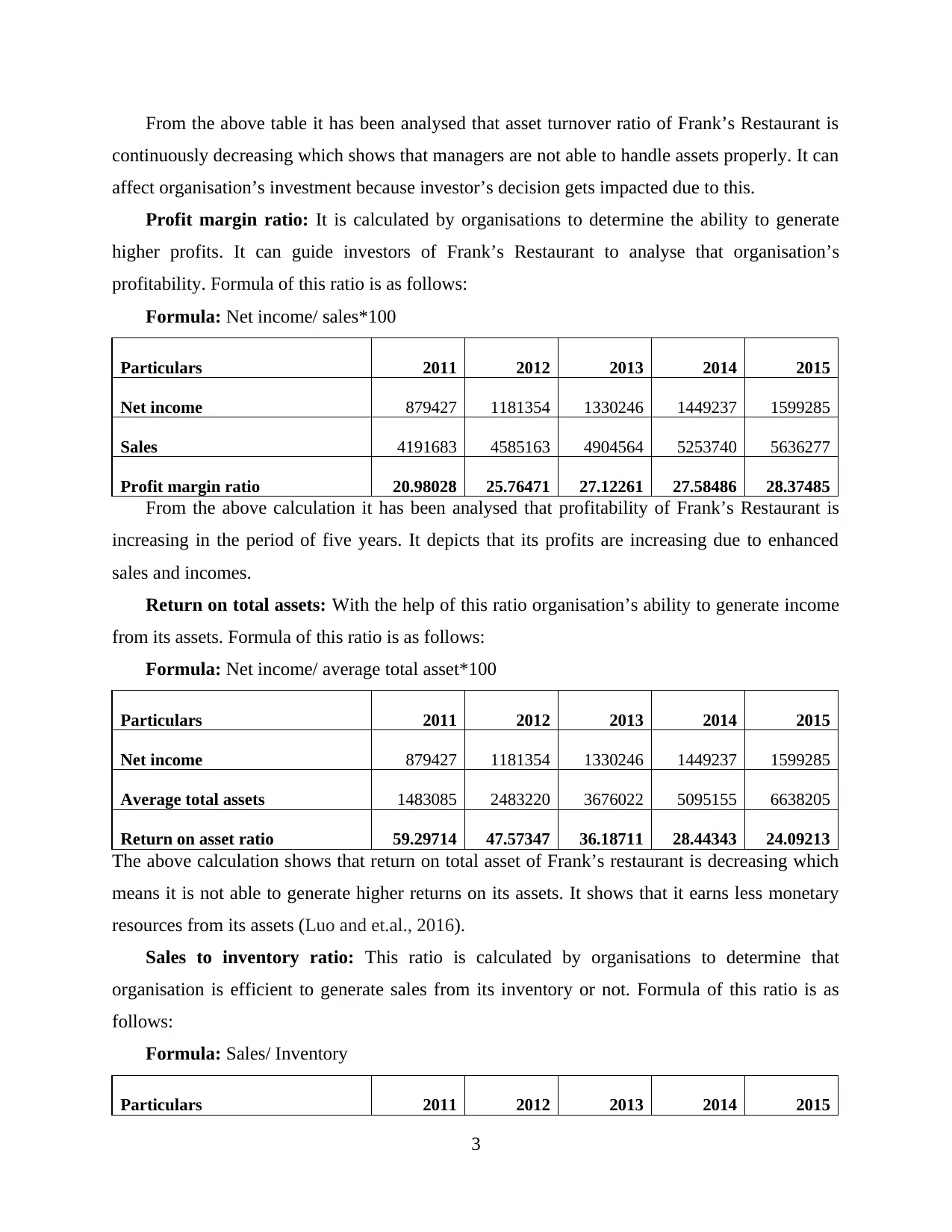
From the above table it has been analysed that asset turnover ratio of Frank’s Restaurant is
continuously decreasing which shows that managers are not able to handle assets properly. It can
affect organisation’s investment because investor’s decision gets impacted due to this.
Profit margin ratio: It is calculated by organisations to determine the ability to generate
higher profits. It can guide investors of Frank’s Restaurant to analyse that organisation’s
profitability. Formula of this ratio is as follows:
Formula: Net income/ sales*100
Particulars 2011 2012 2013 2014 2015
Net income 879427 1181354 1330246 1449237 1599285
Sales 4191683 4585163 4904564 5253740 5636277
Profit margin ratio 20.98028 25.76471 27.12261 27.58486 28.37485
From the above calculation it has been analysed that profitability of Frank’s Restaurant is
increasing in the period of five years. It depicts that its profits are increasing due to enhanced
sales and incomes.
Return on total assets: With the help of this ratio organisation’s ability to generate income
from its assets. Formula of this ratio is as follows:
Formula: Net income/ average total asset*100
Particulars 2011 2012 2013 2014 2015
Net income 879427 1181354 1330246 1449237 1599285
Average total assets 1483085 2483220 3676022 5095155 6638205
Return on asset ratio 59.29714 47.57347 36.18711 28.44343 24.09213
The above calculation shows that return on total asset of Frank’s restaurant is decreasing which
means it is not able to generate higher returns on its assets. It shows that it earns less monetary
resources from its assets (Luo and et.al., 2016).
Sales to inventory ratio: This ratio is calculated by organisations to determine that
organisation is efficient to generate sales from its inventory or not. Formula of this ratio is as
follows:
Formula: Sales/ Inventory
Particulars 2011 2012 2013 2014 2015
3
continuously decreasing which shows that managers are not able to handle assets properly. It can
affect organisation’s investment because investor’s decision gets impacted due to this.
Profit margin ratio: It is calculated by organisations to determine the ability to generate
higher profits. It can guide investors of Frank’s Restaurant to analyse that organisation’s
profitability. Formula of this ratio is as follows:
Formula: Net income/ sales*100
Particulars 2011 2012 2013 2014 2015
Net income 879427 1181354 1330246 1449237 1599285
Sales 4191683 4585163 4904564 5253740 5636277
Profit margin ratio 20.98028 25.76471 27.12261 27.58486 28.37485
From the above calculation it has been analysed that profitability of Frank’s Restaurant is
increasing in the period of five years. It depicts that its profits are increasing due to enhanced
sales and incomes.
Return on total assets: With the help of this ratio organisation’s ability to generate income
from its assets. Formula of this ratio is as follows:
Formula: Net income/ average total asset*100
Particulars 2011 2012 2013 2014 2015
Net income 879427 1181354 1330246 1449237 1599285
Average total assets 1483085 2483220 3676022 5095155 6638205
Return on asset ratio 59.29714 47.57347 36.18711 28.44343 24.09213
The above calculation shows that return on total asset of Frank’s restaurant is decreasing which
means it is not able to generate higher returns on its assets. It shows that it earns less monetary
resources from its assets (Luo and et.al., 2016).
Sales to inventory ratio: This ratio is calculated by organisations to determine that
organisation is efficient to generate sales from its inventory or not. Formula of this ratio is as
follows:
Formula: Sales/ Inventory
Particulars 2011 2012 2013 2014 2015
3
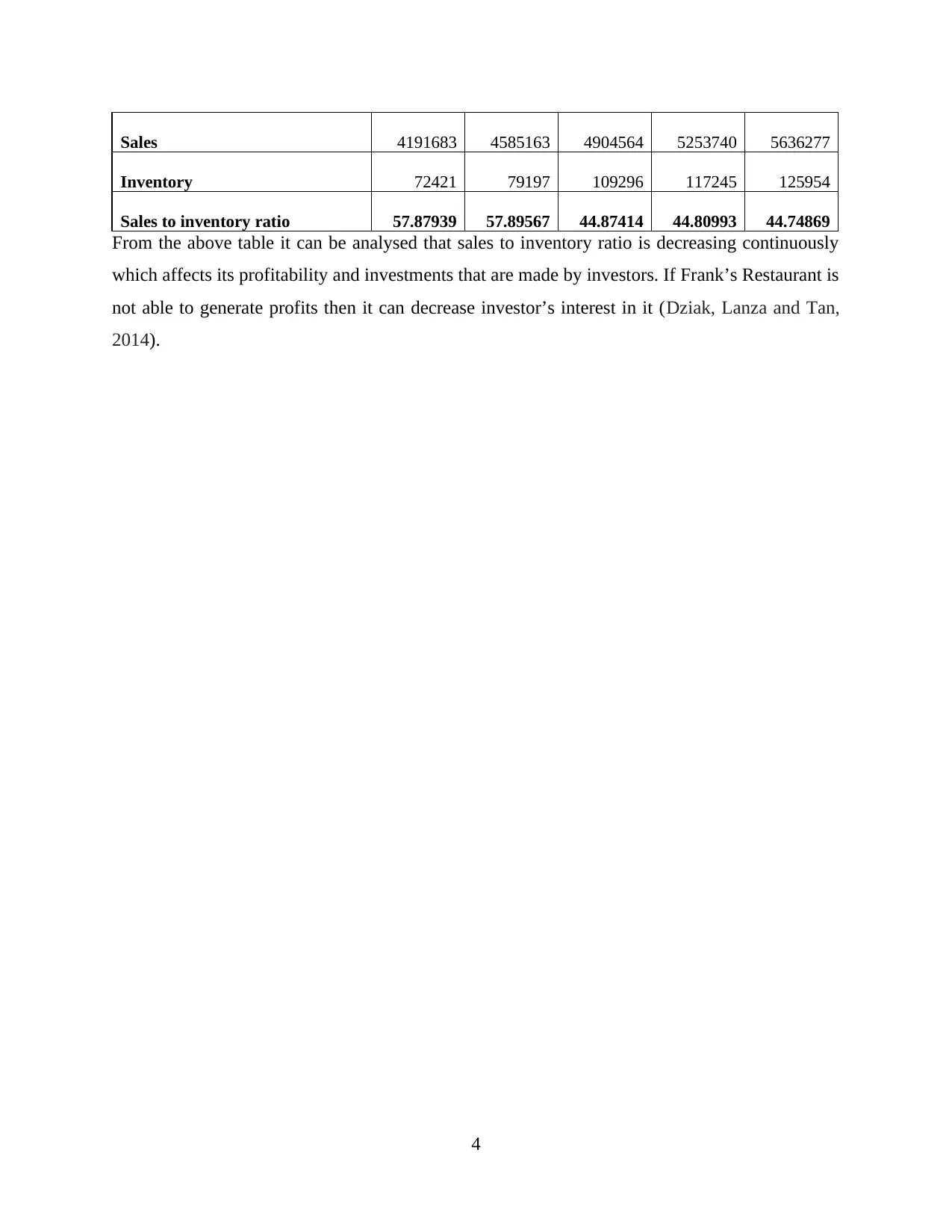
Sales 4191683 4585163 4904564 5253740 5636277
Inventory 72421 79197 109296 117245 125954
Sales to inventory ratio 57.87939 57.89567 44.87414 44.80993 44.74869
From the above table it can be analysed that sales to inventory ratio is decreasing continuously
which affects its profitability and investments that are made by investors. If Frank’s Restaurant is
not able to generate profits then it can decrease investor’s interest in it (Dziak, Lanza and Tan,
2014).
4
Inventory 72421 79197 109296 117245 125954
Sales to inventory ratio 57.87939 57.89567 44.87414 44.80993 44.74869
From the above table it can be analysed that sales to inventory ratio is decreasing continuously
which affects its profitability and investments that are made by investors. If Frank’s Restaurant is
not able to generate profits then it can decrease investor’s interest in it (Dziak, Lanza and Tan,
2014).
4
⊘ This is a preview!⊘
Do you want full access?
Subscribe today to unlock all pages.

Trusted by 1+ million students worldwide
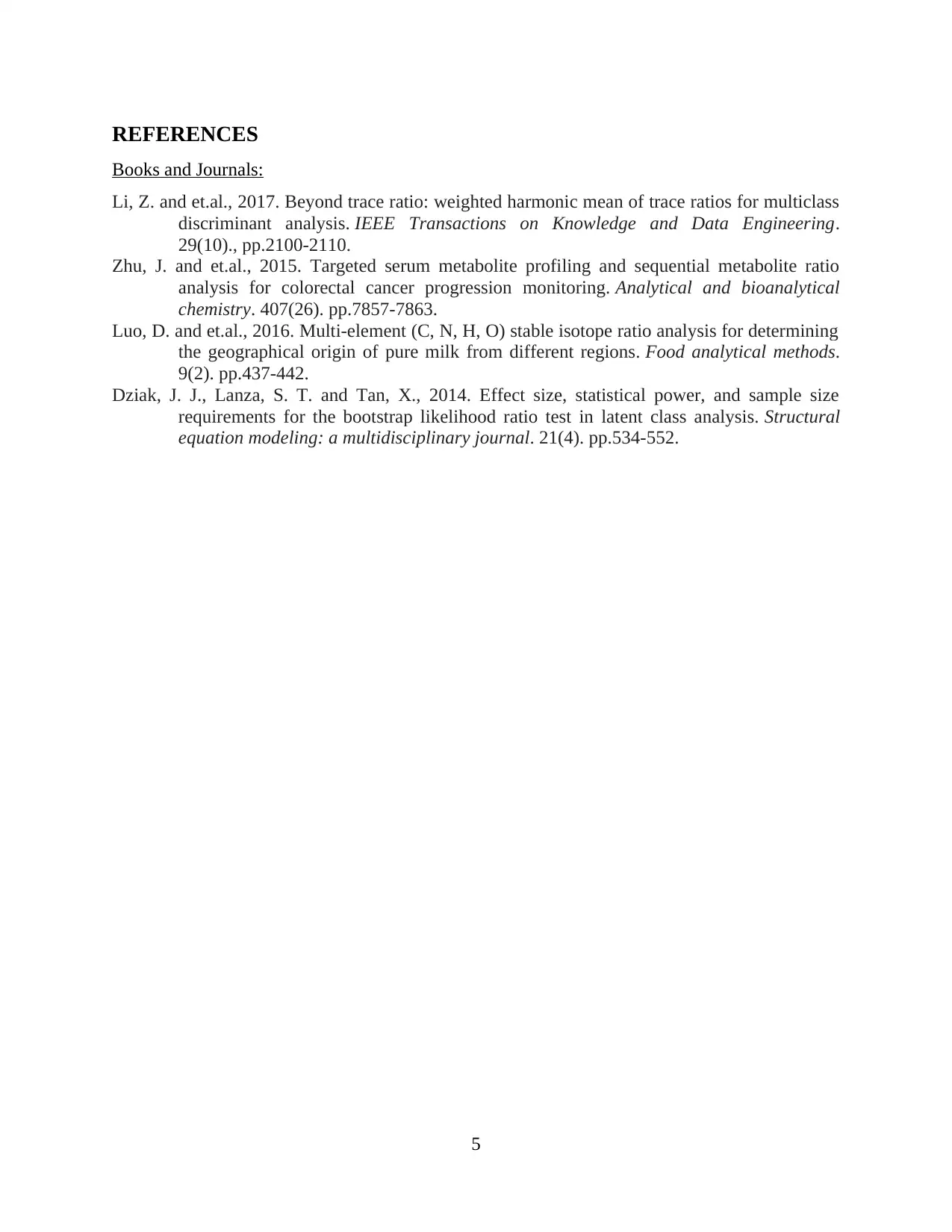
REFERENCES
Books and Journals:
Li, Z. and et.al., 2017. Beyond trace ratio: weighted harmonic mean of trace ratios for multiclass
discriminant analysis. IEEE Transactions on Knowledge and Data Engineering.
29(10)., pp.2100-2110.
Zhu, J. and et.al., 2015. Targeted serum metabolite profiling and sequential metabolite ratio
analysis for colorectal cancer progression monitoring. Analytical and bioanalytical
chemistry. 407(26). pp.7857-7863.
Luo, D. and et.al., 2016. Multi-element (C, N, H, O) stable isotope ratio analysis for determining
the geographical origin of pure milk from different regions. Food analytical methods.
9(2). pp.437-442.
Dziak, J. J., Lanza, S. T. and Tan, X., 2014. Effect size, statistical power, and sample size
requirements for the bootstrap likelihood ratio test in latent class analysis. Structural
equation modeling: a multidisciplinary journal. 21(4). pp.534-552.
5
Books and Journals:
Li, Z. and et.al., 2017. Beyond trace ratio: weighted harmonic mean of trace ratios for multiclass
discriminant analysis. IEEE Transactions on Knowledge and Data Engineering.
29(10)., pp.2100-2110.
Zhu, J. and et.al., 2015. Targeted serum metabolite profiling and sequential metabolite ratio
analysis for colorectal cancer progression monitoring. Analytical and bioanalytical
chemistry. 407(26). pp.7857-7863.
Luo, D. and et.al., 2016. Multi-element (C, N, H, O) stable isotope ratio analysis for determining
the geographical origin of pure milk from different regions. Food analytical methods.
9(2). pp.437-442.
Dziak, J. J., Lanza, S. T. and Tan, X., 2014. Effect size, statistical power, and sample size
requirements for the bootstrap likelihood ratio test in latent class analysis. Structural
equation modeling: a multidisciplinary journal. 21(4). pp.534-552.
5
Paraphrase This Document
Need a fresh take? Get an instant paraphrase of this document with our AI Paraphraser
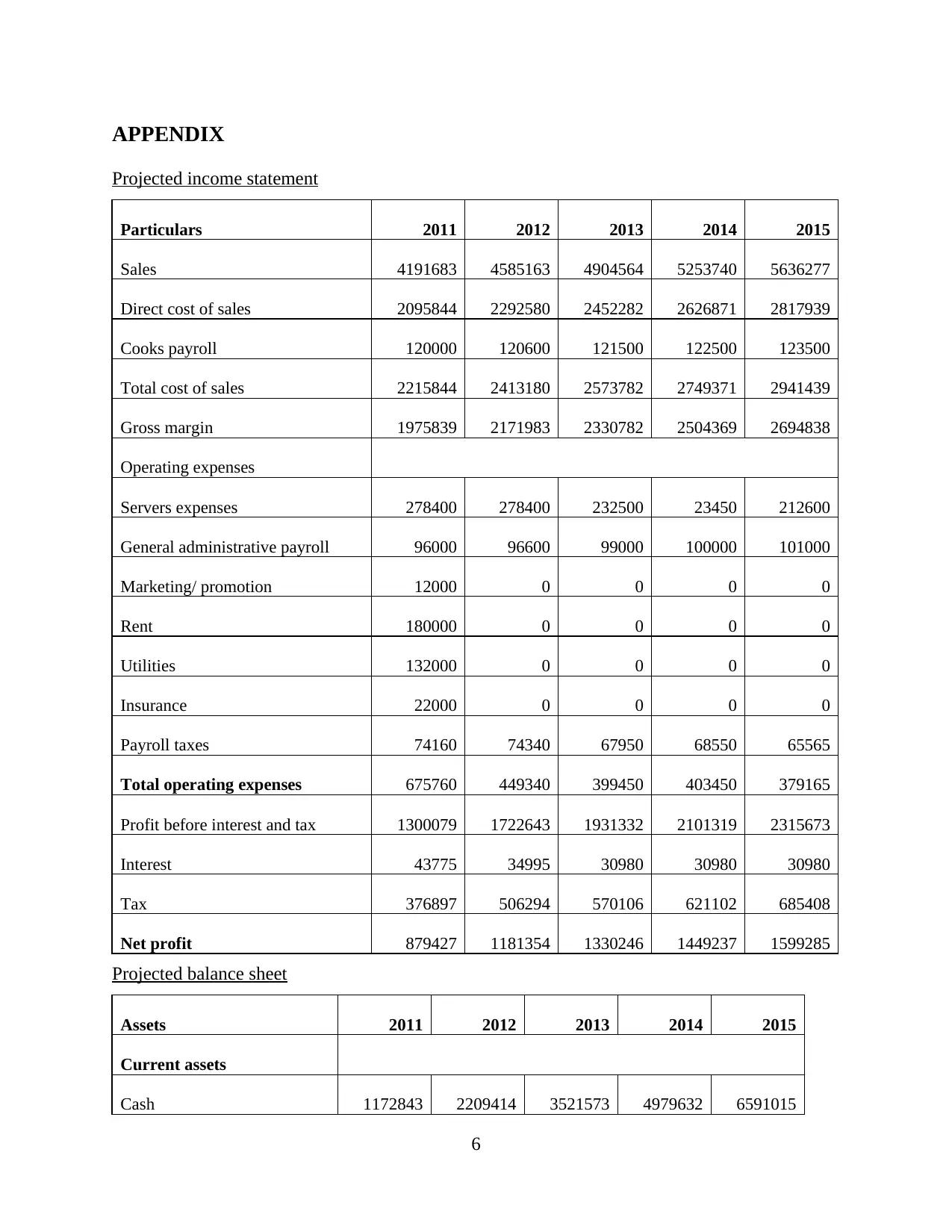
APPENDIX
Projected income statement
Particulars 2011 2012 2013 2014 2015
Sales 4191683 4585163 4904564 5253740 5636277
Direct cost of sales 2095844 2292580 2452282 2626871 2817939
Cooks payroll 120000 120600 121500 122500 123500
Total cost of sales 2215844 2413180 2573782 2749371 2941439
Gross margin 1975839 2171983 2330782 2504369 2694838
Operating expenses
Servers expenses 278400 278400 232500 23450 212600
General administrative payroll 96000 96600 99000 100000 101000
Marketing/ promotion 12000 0 0 0 0
Rent 180000 0 0 0 0
Utilities 132000 0 0 0 0
Insurance 22000 0 0 0 0
Payroll taxes 74160 74340 67950 68550 65565
Total operating expenses 675760 449340 399450 403450 379165
Profit before interest and tax 1300079 1722643 1931332 2101319 2315673
Interest 43775 34995 30980 30980 30980
Tax 376897 506294 570106 621102 685408
Net profit 879427 1181354 1330246 1449237 1599285
Projected balance sheet
Assets 2011 2012 2013 2014 2015
Current assets
Cash 1172843 2209414 3521573 4979632 6591015
6
Projected income statement
Particulars 2011 2012 2013 2014 2015
Sales 4191683 4585163 4904564 5253740 5636277
Direct cost of sales 2095844 2292580 2452282 2626871 2817939
Cooks payroll 120000 120600 121500 122500 123500
Total cost of sales 2215844 2413180 2573782 2749371 2941439
Gross margin 1975839 2171983 2330782 2504369 2694838
Operating expenses
Servers expenses 278400 278400 232500 23450 212600
General administrative payroll 96000 96600 99000 100000 101000
Marketing/ promotion 12000 0 0 0 0
Rent 180000 0 0 0 0
Utilities 132000 0 0 0 0
Insurance 22000 0 0 0 0
Payroll taxes 74160 74340 67950 68550 65565
Total operating expenses 675760 449340 399450 403450 379165
Profit before interest and tax 1300079 1722643 1931332 2101319 2315673
Interest 43775 34995 30980 30980 30980
Tax 376897 506294 570106 621102 685408
Net profit 879427 1181354 1330246 1449237 1599285
Projected balance sheet
Assets 2011 2012 2013 2014 2015
Current assets
Cash 1172843 2209414 3521573 4979632 6591015
6
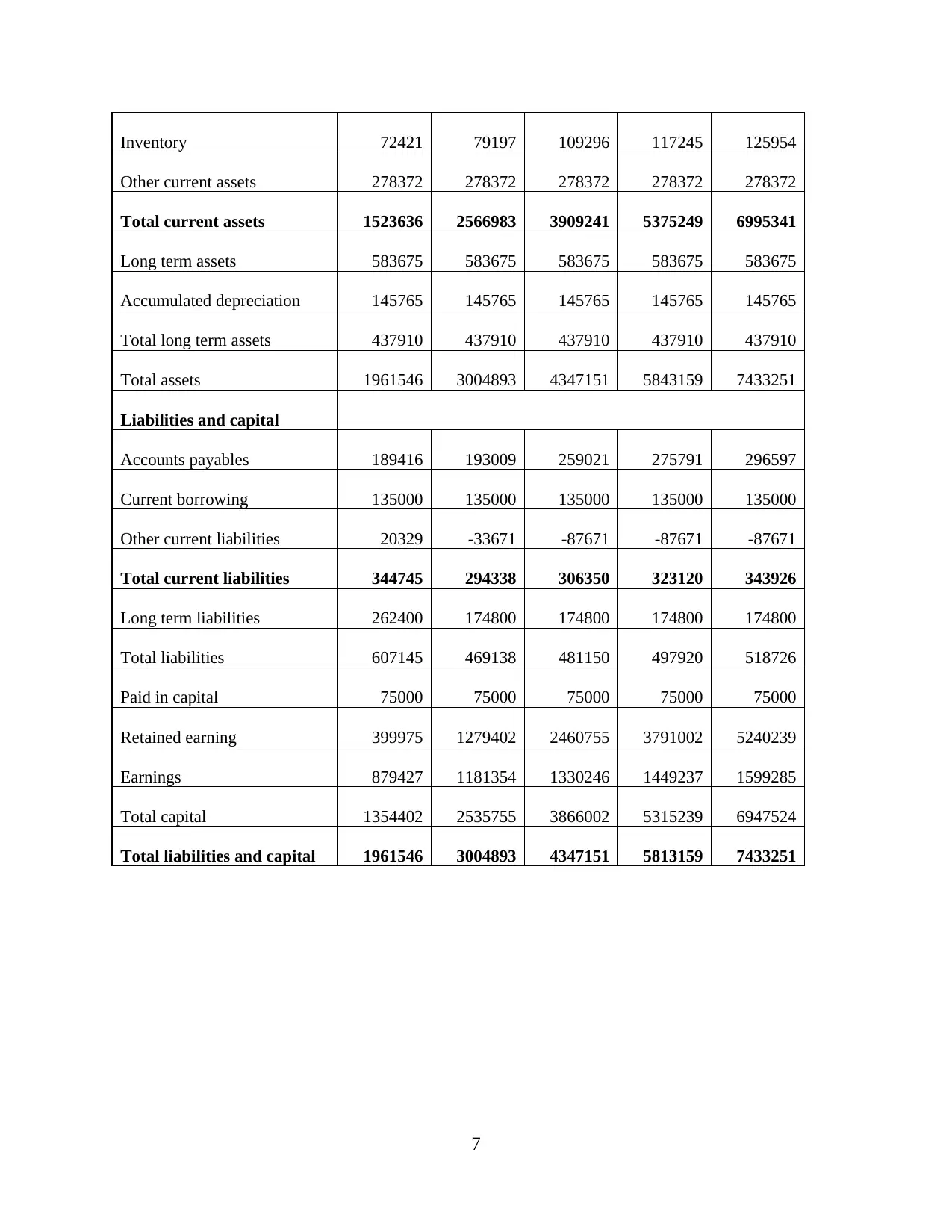
Inventory 72421 79197 109296 117245 125954
Other current assets 278372 278372 278372 278372 278372
Total current assets 1523636 2566983 3909241 5375249 6995341
Long term assets 583675 583675 583675 583675 583675
Accumulated depreciation 145765 145765 145765 145765 145765
Total long term assets 437910 437910 437910 437910 437910
Total assets 1961546 3004893 4347151 5843159 7433251
Liabilities and capital
Accounts payables 189416 193009 259021 275791 296597
Current borrowing 135000 135000 135000 135000 135000
Other current liabilities 20329 -33671 -87671 -87671 -87671
Total current liabilities 344745 294338 306350 323120 343926
Long term liabilities 262400 174800 174800 174800 174800
Total liabilities 607145 469138 481150 497920 518726
Paid in capital 75000 75000 75000 75000 75000
Retained earning 399975 1279402 2460755 3791002 5240239
Earnings 879427 1181354 1330246 1449237 1599285
Total capital 1354402 2535755 3866002 5315239 6947524
Total liabilities and capital 1961546 3004893 4347151 5813159 7433251
7
Other current assets 278372 278372 278372 278372 278372
Total current assets 1523636 2566983 3909241 5375249 6995341
Long term assets 583675 583675 583675 583675 583675
Accumulated depreciation 145765 145765 145765 145765 145765
Total long term assets 437910 437910 437910 437910 437910
Total assets 1961546 3004893 4347151 5843159 7433251
Liabilities and capital
Accounts payables 189416 193009 259021 275791 296597
Current borrowing 135000 135000 135000 135000 135000
Other current liabilities 20329 -33671 -87671 -87671 -87671
Total current liabilities 344745 294338 306350 323120 343926
Long term liabilities 262400 174800 174800 174800 174800
Total liabilities 607145 469138 481150 497920 518726
Paid in capital 75000 75000 75000 75000 75000
Retained earning 399975 1279402 2460755 3791002 5240239
Earnings 879427 1181354 1330246 1449237 1599285
Total capital 1354402 2535755 3866002 5315239 6947524
Total liabilities and capital 1961546 3004893 4347151 5813159 7433251
7
⊘ This is a preview!⊘
Do you want full access?
Subscribe today to unlock all pages.

Trusted by 1+ million students worldwide
1 out of 9